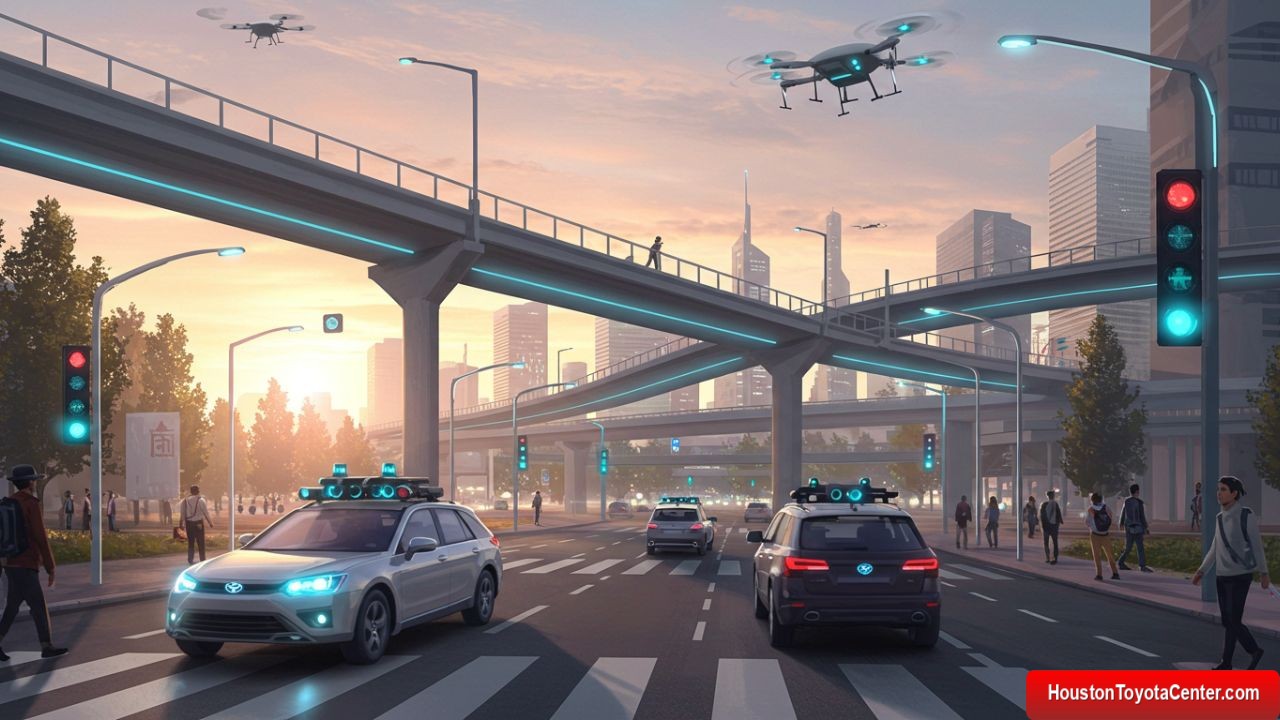Imagine a future where cars no longer crash. Where roads are places of harmony, not hazards. Where every journey ends safely. This is not a science fiction dream—it’s Toyota’s bold Vision 2050.
Toyota’s Vision 2050 isn’t just about cars; it’s about humanity. With technological breakthroughs in automation, AI, vehicle-to-everything (V2X) communication, sustainability, and human-centric design, Toyota is charting a course to a zero-accident future. In a world where over 1.3 million people die annually from road traffic accidents, this mission holds profound importance.
In this in-depth article, we’ll explore how Toyota plans to eliminate traffic accidents entirely by 2050. From their advanced safety systems and artificial intelligence to connected infrastructure and autonomous mobility, we’ll journey through the roadmap to a safer tomorrow.
The Grim Reality of Today’s Roads
Every day, thousands of lives are disrupted by preventable crashes. According to the World Health Organization (WHO):
FREE: Quickly identify and understand problems with your vehicle 🚘
CLICK HERE- 1.3 million people die annually from road traffic crashes.
- 93% of deaths occur in low- and middle-income countries.
- Road crashes are the leading cause of death for people aged 5–29.
These numbers are not just statistics—they are stories cut short. For Toyota, these tragedies are unacceptable. That’s why safety is not an afterthought; it’s the foundation of their innovation strategy.
What Is Toyota’s Vision 2050?
Toyota’s Vision 2050, first unveiled in 2015 and constantly evolving, is a long-term sustainability framework that includes:
- Zero traffic fatalities
- Zero environmental impact
- Mobility for all
In this vision, the concept of mobility is not limited to transportation—it encompasses freedom, safety, accessibility, and dignity.
Toyota is investing billions into a multi-pronged approach to prevent crashes before they happen. This involves:
- Smart AI-driven vehicles
- Fully autonomous transportation
- Connected road infrastructure
- Human-machine synergy
- Continuous learning from driving data
Key Pillars of Toyota’s Zero-Accident Strategy
1. Mobility Teammate Concept (MTC)
Rather than creating cold, robotic cars, Toyota’s Mobility Teammate Concept envisions autonomous vehicles as partners to human drivers.
“It’s not just the car driving itself. It’s the car working with you, anticipating, learning, and helping,” — Toyota Research Institute (TRI)
This includes:
- Monitoring driver behavior to step in during distraction or fatigue
- Communicating via emotion-aware AI
- Collaborative driving where control is shared dynamically
This creates redundant layers of safety, especially during emergencies.
2. Toyota Guardian System
Think of Guardian as an invisible co-pilot. This system constantly watches the environment and intervenes only when necessary.
Key features:
| Feature | Description |
|---|---|
| Sensor Fusion | Combines data from radar, lidar, and cameras to detect risks in real time |
| Driver Monitoring | Uses in-cabin cameras to evaluate alertness and readiness |
| Emergency Override | Automatically takes control if a collision is imminent |
| Predictive Analysis | Anticipates potential hazards several seconds in advance |
Guardian is already being integrated into vehicles like the Toyota Mirai and Lexus LS.
3. Toyota Research Institute (TRI)
Established in 2016, TRI is the nerve center for Toyota’s AI-driven safety systems. With facilities in Silicon Valley, TRI has:
- Developed deep learning models to detect edge-case scenarios
- Created simulation platforms for testing millions of scenarios
- Partnered with MIT and Stanford for ethical AI research
Their work fuels innovations like behavioral cloning, neural predictive models, and fail-operational architecture.
4. Woven City: A Living Lab for Safety
At the base of Mt. Fuji, Toyota is building Woven City—a prototype city where real people will live among fully autonomous cars, smart homes, and AI-powered infrastructure.
Woven City will test:
- Connected crosswalks that communicate with vehicles
- Predictive traffic lights that adjust in real time
- Zero-emission shuttles with 360° pedestrian detection
- Robotic caregivers for elderly mobility
This city is not only futuristic—it’s a testbed for a world without crashes.
5. Vehicle-to-Everything (V2X) Communication
V2X is the idea that cars should not just sense the world—they should talk to it.
Toyota is investing heavily in:
- V2V (Vehicle-to-Vehicle): Cars share their speed, trajectory, and braking patterns.
- V2I (Vehicle-to-Infrastructure): Cars get real-time info from traffic lights, roads, and signs.
- V2P (Vehicle-to-Pedestrian): Smart devices in people’s hands help cars “see” them.
In Japan, Toyota is already testing ITS Connect, which uses V2X to cut accidents at blind intersections by up to 40%.
6. Autonomous Driving: Level 4 & Beyond
Toyota’s “Chauffeur Mode” is its path to full autonomy, starting with controlled environments like:
- Corporate campuses
- Hospitals
- Airports
- Residential areas
These vehicles are being built to:
- React faster than humans
- Drive safely in all conditions
- Handle rare events through real-time data fusion
By 2030, Toyota aims to deploy Level 4 autonomous vehicles on a wider scale—potentially preventing millions of crashes annually.
7. Human-Centric UX and Accessibility
Technology isn’t enough if people can’t use it. That’s why Toyota also focuses on:
- Voice-controlled interfaces for reduced distraction
- Haptic feedback systems to improve driver reaction
- Interfaces for visually or physically impaired users
From elderly-friendly cockpits to multilingual assistance systems, Toyota envisions a future where no one is left behind.
Real-World Impact: Safety Features Already in Use
You don’t have to wait until 2050—Toyota is rolling out safety innovations today. Here are some available features in 2025 models:
| Safety Tech | Available In | Function |
|---|---|---|
| Pre-Collision System | Corolla, RAV4, Tundra | Warns and brakes if a frontal collision is likely |
| Lane Tracing Assist | Camry, Highlander | Keeps the car centered in its lane using cameras |
| Road Sign Assist | Prius, bZ4X | Detects signs and shows them on the dash |
| Blind Spot Monitor | Sienna, 4Runner | Alerts when another car is in your blind spot |
These technologies already reduce accidents by up to 35% according to internal studies.
Challenges Toyota Must Overcome
Of course, achieving a zero-accident world is no easy feat. Obstacles include:
- Ethical Dilemmas: How should autonomous cars react in impossible moral scenarios?
- Public Trust: Many people are still afraid of self-driving tech.
- Infrastructure: V2X only works if governments upgrade roads and systems.
- Cybersecurity: Cars connected to the internet must be protected from hacking.
- Cost and Accessibility: Safety must be for everyone, not just the wealthy.
Toyota addresses these with partnerships, education campaigns, open-source platforms, and government lobbying for future-ready infrastructure.
Global Partnerships and Collaborations
Toyota collaborates with a broad range of partners to accelerate progress:
- NVIDIA & Microsoft for real-time AI processing
- Uber (historically) for ride-sharing autonomous testing
- Government agencies in Japan and the U.S. for infrastructure readiness
- Startups and universities for agile innovation and ethics research
These partnerships are critical to scale innovations globally, not just in tech-savvy nations.
A Safer World Is Possible—And It’s Closer Than You Think
Toyota’s Vision 2050 is not a fantasy—it’s already unfolding. Through intelligent design, autonomous cooperation, human empathy, and relentless innovation, Toyota is transforming the very nature of mobility.
By 2050, traffic deaths could be a relic of the past. Streets may no longer echo with sirens but resonate with confidence, care, and calm. Toyota isn’t just building cars. It’s building a world where no one has to say goodbye too soon because of a crash.
As the company puts it:
“We will never stop innovating until there are zero accidents. Because every life matters.”


Leave a Reply